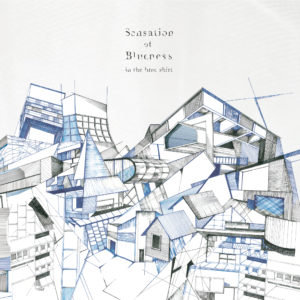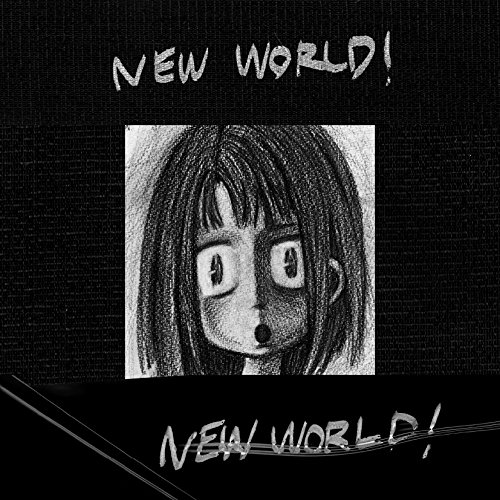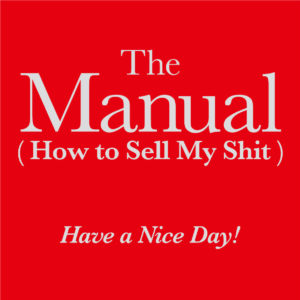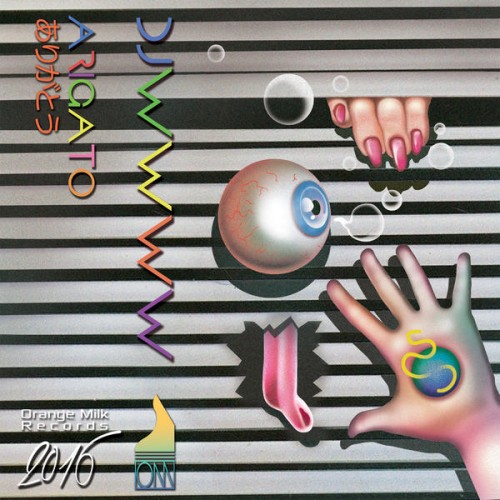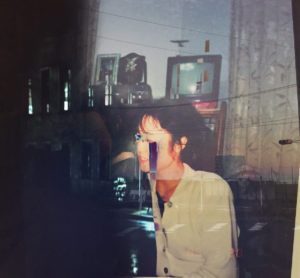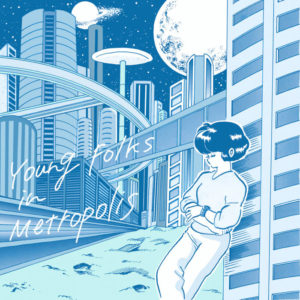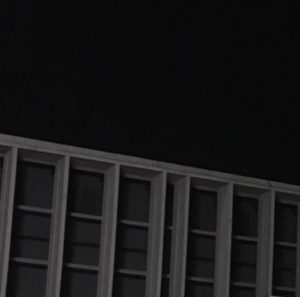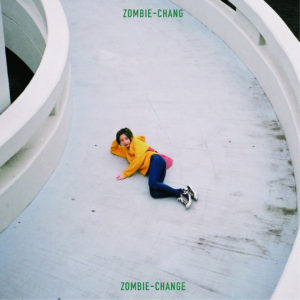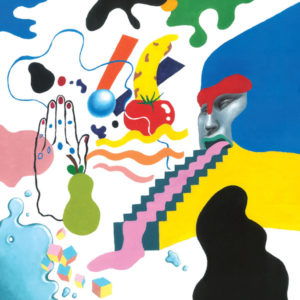Make Believe Melodies’ Best Japanese Albums 2016: #10 – #01
#10 In The Blue Shirt Cyanotype And Sensation Of Blueness
Across these two brief but busy releases, Osaka’s In The Blue Shirt transmogrified the familiar into alien forms. His approach to music remains the same — grab a line or a few from a song, whether it be an obscure cut or a global smash hit courtesy Lorde, slice it thin and then spice up certain words by speeding or slowing them down. Vocals being warped in this way are a pretty common phenomenon in electronic music, in particular certain SoundCloud-centric scenes. But In The Blue Shirt puts the focus on them, creating dizzying songs powered by rapid-fire vocal snippets. Cyanotype and Sensation Of Blueness were his most focused collections yet, his whirlwind vocal construction tighter than ever before, backed by chilled-out woodwinds and unobtrusive beats that at this loosest gave these songs the feel of a high-energy Peanuts cartoon. Get Cyanotype here, and Sensation Of Blueness here.
#9 Fuji Chao Tanoshi Bunretsusyou
As we hit the home stretch of this list, a unifying theme — not in all of the releases ahead, but in most of them — is a sense of being invited into an artist’s world, where they are free to experiment with sounds as they wish (In The Blue Shirt falls in this category) or reveal themselves in whatever way they’d like. Fuji Chao exists in the latter, and her Tanoshi Bunretsusyou creeped out of the shadows to become one of the year’s most personal…at times unsettlingly so…albums of the year.
Few descriptions of what an artist is all about bests Fuji Chao’s Bandcamp declaration “19 years old *sigh*.” Her music runs from minimalist, back-tracked shuffles (“Romeo Magic Baby”) to electro-flurries backed by trap beats (“Answer”), with the bulk of her tracks sampling extensively, from BGM tracks I’m pretty sure I’ve heard in YouTube vlogs to snippets of anime (done in a way less Crunchyroll-core and more like Shortcake Collage Cake, in a way evoking a lived nostalgia). Above them all, Chao herself delivers spoken word, her voice moving from frantic on the pulsing “Remember Summer” to mimicking hysteric crying on “Syoujyo.” Comparing it to a diary seems dismissive — Tanoshi Bunretsusyou feels more like a secret space to retreat into, and let feelings of all sorts just flow forth without worry. Get it here, or listen below.
#8 Soutaiseiriron Tensei Jingle
Soutaiseiriron have been the most influential band in Japanese music for a while now. Plenty of indie bands — and, in recent times, mainstream bands (Passepied, even Gesu No Kiwami Otome.) and artists such as Daoko or Izumi Makura — have adopted the group’s Showa-era vibe, or they’ve mimicked the speak-sing delivery of Etsuko Yakushimaru. And with their fifth album Tensei Jingle, they found themselves putting out music smack-dab in a year where Japan’s best releases were eschewing meaning entirely in favor of exploring just how far sounds could be pushed. Well, what a luck, that’s what Soutaiseiriron have been doing for a decade now. Tensei Jingle features darty rock songs and slower electronic numbers in the mold of The Knife, all of it seeming cryptic both sonically and lyrically. Yet the songs here find Yakushimaru singing about soda and dogs, with a few weightier topics sneaking in, but even then feeling like happy accidents. For all the secrecy and drama Soutaiseiriron indulge in, they’ve always been far more interested in how language sounds and the little tricks you can pull with words rather than trying to dwell on the definition. As luck would have it, the best music of 2016 subscribed to a familiar mindset. But even removed from that, Tensei Jingle was one of the group’s strongest all-around efforts, and a reminder of why so many others have been drawn to them for inspiration.
#7 Have A Nice Day! The Manual (How To Sell My Shit)
Stupid, chaotic escape can be plenty fun, but sometimes you crave something just a touch more fulfilling. Have A Nice Day! run in Tokyo music circles defined by high-energy, manic live shows, and they certainly know how to wow a crowd too. Yet unlike bands who might consider themselves more on the performing arts side of things if you really pressed them about it, Have A Nice Day! make music that you not only want to listen to away from the comfort of a livehouse, but the sort of rock anthems that approach embarrassing earnestness, but never turn to cheese because of just how committed they are to it. The title reads like a goof, but The Manual (How To Sell My Shit) overflows with life-affirming and borderline naive romance, delivered through chintzy synthesizers, beats, guitars and, most importantly, the vocals, understated until they rise to something fierce. This isn’t purely a phones-in-the-air affair. They manage a glam-indebted stomp on “666,” and get cryptic alongside World’s End Girlfriend on “New Romance,” which works in chipmunked vocal samples. Yet the darker corners always make way for songs such as “Dance With My Climax (Void Void)” and “Love Supreme,” twinkling numbers that wow in hectic live settings and can transform a walk home into an epic. Get it here.
#6 DJWWWW Arigato
This has been the year I’ve accepted I’m addicted to the internet, but also the year I started questioning if spending so much time online was really benefitting me anymore. Before, I could point to tangible benefits: new information, new friends, new viewpoints. But it felt…off in 2016, less exciting and more exhausting, loaded with more takes and news (or “news”) than ever before, but all of it ultimately just colliding together into noise. Not to say it was without good, personal or more widespread, but it felt too extra.
Arigato felt like an apt soundtrack for this sinking realization, DJWWWW stringing video game splat sounds, Young Thug and about a hundred other noises together into songs, disjointed but thrilling in their unpredictably. My internet bellyaching distracts from Arigato being the Yamaguchi-based producer’s finest release using this high-definition collage style. Yet it also resonated even more in a chaotic year like 2016, where Arigato felt like a proper backdrop for a year oversaturated with information. Get it here or listen below.
#5 Metoronori Osanasa No Shishi
Imagined worlds don’t have to make much sense, or even have much of a flow to them. Bedroom producer Metoronori has been crafting alternate universe pop for the last few years, creating barely-there electronic numbers full of distorted notes and a dream-like haze. Her vocals came in and out, rarely rising above a murmur. Yet from these disjointed sounds emerged pop songs…maybe pop fragments, catchy for the brief time they flickered. Osanasa No Shishi finds Metoronori further plumbing these depths, exploring what happens when fragile, disparate sounds bump into one another, and seeing what comes out of it. The antithesis of Arigato, Osanasa No Shishi explores the interesting outskirts of space and secrecy, with plenty of beauty hiding deep within. Get it here.
#4 Various Artists Young Folks In Metropolis
March 26, 2016: Jesse Ruins holds their final live show ever, in a smoky live spot in Shibuya. The people attending all look familiar, the same faces popping up at indie shows in Tokyo over the last five years. The conversations sounded different though — “oh, your married now!” “work is going well, but it’s so busy.” Though who was I to judge — I didn’t get out to these sort of shows much anymore either, opting to stay in and actually sleep rather than stay out until the subway started. A month later, I’d go to a farewell party with a lot of the same people in attendance. It all felt nostalgic, of a time now over.
September 15, 2016: Young Folks in Metropolis comes out, organized by Tokyo’s Poor Vacation and featuring names from all over Japan’s independent music scene. Some of them have been playing and releasing music for years — Super VHS teamed up with Mai Ehara (formerly known as May.e) for the jittery synth-pop of “Sakana No Koi,” while Osaka’s Soleil Soleil…formerly Omegaboy, ahead of the tropical house wave…delivered with the rollicking “Happy Pill.” Yet others are relatively new names, including Nite Body’s slowly unfolding synth jam “Mercury Falls” and Far Farm’s nocturnal “Secret.” Pictured Resort and Half Mile Beach Group both released solid albums in 2016, but delivered their most thrilling songs here, with the twinkling beach house of of “Days In Maui” and the off-season indie dance of “Monica,” respectively. Touching on all sorts of styles and perspectives across 15 songs, Young Folks in Metropolis’ most enduring quality is the reminder that this sort of underground music always persists, regardless of how time makes you feel. Get it here or listen below.
#3 Various Artists Atomic Bomb Compilation Vol. 4
The Atomic Bomb Compilation series emerged in post-Fukushima Japan, spurred by the government mishandling and misdirection in the wake of a nuclear accident but pushed forward by the ghosts of Hiroshima and Nagasaki, circa 1945. Across the first three offerings, it has always been an ominous listen, juke artists from Japan (and, eventually, abroad) capturing the unease that the nuclear age wrought, the jittery beats and sliced-up samples of the Chicago-born genre making for an especially appropriate vessel.
Vol. 4, though, feels especially urgent and dark. The faster tracks here, courtesy of CRZKNY and Gnyonpix among others, sound more metallic, the synths signalling something evil on the horizon. More slow-burning songs dot this edition, the whole thing even starting with the alarm-signal lurch of jue6ons “e_i_r.” The series has never approached anything as intense as lililL’s “Atomic Explosion,” a whirlwind of bass and clang. And then there were the highly relevant moments, like Chicago producer bahnhof::zoo’s “Fell From The Sky,” sampling lines from Barack Obama’s historic speech this spring, or Count Vanderhoff’s use of a quote referencing current British PM Theresa May’s emphatic support of using nuclear weapons to kill innocent people, if necessary. As it has been for the last few years, it offered the best go-to place to listen to developing juke producers. But Vol. 4 also sounded particularly of 2016, and only felt more so as the year carried on. Get it here or listen below.
#2 Zombie-Chang Zombie-Change
Plenty of Japanese artists tried to stand out from the masses in 2016 by embracing older sounds and labelling themselves as “alternative.” Yet next to none of these acts — solo, group or idol — created anything particularly interesting musically, let alone in something that sets them apart from…everyone else doing the same thing. Not the case on Zombie-Chang’s Zombie-Change. Formerly an artist shouting over acoustic guitar strums — “freak-folk” in a bygone decade — she channeled new wave sounds on this, her about face. And plenty others, some in the same scene she occupied, did too, but so many of those felt like cheap imitation for branding sakes, without any substance. Zombie-Chang, though, uses these nervy electronic sounds as a springboard to express herself, in all of her oddball glory. She penned unnerving pop (“Lemonade”), fidgety bouncers (“Goodbye My Love and Turn Around”) and barely-there reflections (“Korede Owari?”). She could make a high-energy song about PMS one moment, and then swing around to crafting one of the most downtrodden slow songs of the year. Zombie-Change was many things — unpredictable, fun, a fantastic intro to an artist who in a just world would be creeping on the outskirts of mainstream visibility — but above all else, it was a look into the mindset of an exciting young creator.
#1 Foodman Ez Minzoku
Before potentially getting lost in the sort of pondering the top spot on a year-end list typically brings out in writers, it must be stressed — Ez Minzoku is among the most fun albums released in 2016. Foodman (a.k.a Shokuhin Matsuri) uses a limited sonic palette, but he makes every noise count, from MIDI horn to electric guitar riff. It’s a wonky and experimental set, sure, but also a warm one happy to get goofy when necessary, Foodman aware that great music can be downright funny when needed.
That’s because Foodman obsesses over sound, exploring individual noises and letting them hand out in all of their sparse glory. Japanese music in 2016 was full of artists carving out their own worlds, whether via emotion (Fuji Chao), language structure (Soutaiseiriron), a little of both (Zombie-Chang, Metoronori) or by dissecting sound. This trend has been bubbling for a few years now (see Taquwami’s Moyas EP from 2015 for one ahead of its time), and Foodman himself was one of the key players. On early releases — spread out across all sorts of labels and online pages — he played around with the structure of juke music and traditional Japanese festival music, seeing how far he could push it. And just how much he could strip it down. See songs constructed from only the sound of a handclapping and a bee buzzing.
He perfected this how-minimal-can-you-get approach the same year compatriots like DJWWWW, Toiret Status, In The Blue Shirt, Metome and others released albums where meaning took a secondary role to sonic exploration. And Ez Minzoku was the best of the bunch. “It’s almost a more bizarre record, because he’s using a lot of MIDI sounds, and it’s almost like there’s a lot of negative space,” Orange Milk co-founder Keith Rankin told me this year. “To be minimal is to be the hardest thing musically for a lot of people. Pulling it off in the way he did is really cool.”
Just as cool? Making an album where meaning was crushed up into a paper ball and thrown into a waste bin. Foodman reimagines “Jazz” as a series of heads screaming off over loopy whistles. “Rock” still features electric guitar and drums, but boiled down to their core molecules. “Waterfall” becomes crystal, and Taigen Kawabe of Bo Ningen becomes demented prophet-slash-actor, ushering in all the wackiness to come on opener “Beybey.” Emotion still comes through — see the sweet “Mid Summer Night” featuring Diskomargaux for the best example — as do recognizable words. With the latter, though, rarely do they mean anything. This is the point where I’d like to ramble about how Ez Minzoku worked perfectly in a year where facts completely broke through, but we’d be veering off into even wordier territory.
And anyway, why waste words when all that really has to be said is so simple? Ez Minzoku is Foodman’s big breakthrough, and one that didn’t come easy. He’s been tinkering with this style for years, and Ez Minzoku represents his finest moment yet, using a sparse set of sounds to create one of the most engaging, interesting and fun out of anywhere in 2016, a release where every sound conjures up a dozen adjectives. And it represented the peak of Japan’s experimental electronic scene, which blossomed in 2016 and produced the nation’s best sounds. Get it here, or listen below.

